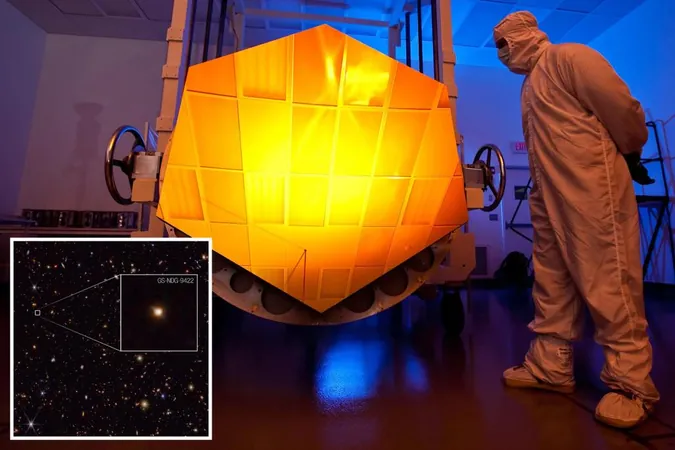
James Webb Telescope Uncovers ‘Missing Link’ to the Birth of the Universe!
2024-10-03
Author: Lok
James Webb Telescope Uncovers ‘Missing Link’ to the Birth of the Universe!
In a thrilling turn of events reminiscent of a science fiction saga, the James Webb Space Telescope (JWST) has made an extraordinary discovery in the cosmos that could serve as a critical “missing link” in our understanding of the early universe and the birth of its first stars.
The telescope has pinpointed a unique region in space where stars within the galactic system known as GS-NDG-9422 are exhibiting an “odd light signature.” This astonishing phenomenon is attributed to gases in the galaxy emitting more light than the stars themselves. Remarkably, this galaxy was formed approximately one billion years after the Big Bang, shedding light on a previously murky chapter of cosmic history.
“My initial reaction to the galaxy’s spectrum was simply, ‘That’s weird,’” said researcher Alex Cameron, who is behind this groundbreaking study published in the Monthly Notices of the Royal Astronomical Society. Cameron emphasized that understanding this peculiar data could be key to piecing together the cosmic tale of our universe's beginnings.
To dig deeper, Cameron and his colleague, theorist Harley Katz, started running advanced computer simulations. Their models mirrored the observations made by the Webb telescope, suggesting the presence of Population III stars, the very first stars born in the universe. According to Katz, “It appears these early stars were significantly hotter and more massive than the stars we are familiar with today, reflecting the vastly different conditions present in the early universe.”
In stark contrast, the hot stars we observe closer to Earth have surface temperatures ranging from 70,000 to 90,000 degrees Fahrenheit. However, the stars within galaxy 9422 blaze at scorching temperatures exceeding 140,000 degrees Fahrenheit! This intense heat is thought to result from a brief yet vigorous phase of star formation that overwhelmed the surrounding gas clouds, causing them to absorb an immense influx of photons, much like asphalt sizzling under a relentless sun.
Although GS-NDG-9422 may not host any Population III stars yet, Katz explained that the stellar inhabitants of this galaxy are unlike anything we have encountered so far. “The exotic stars in this galaxy could act as beacons, guiding us in understanding the evolution from primordial stars to the galaxies we recognize today,” he added.
Thanks to the JWST, we are venturing into the uncharted territories of deep space, embarking on what could be one of the most exciting explorations of our time. “This is just the tip of the iceberg,” Cameron noted, expressing enthusiasm for the future discoveries that lie ahead. “We are on the cusp of unveiling secrets of the universe that were once beyond our reach.”
As astronomers and researchers prepare for further exploration of the cosmos, the JWST proves to be an unparalleled tool, opening doors to a deeper understanding of our universe's origins and forcing us to reconsider everything we thought we knew about the stars and galaxies that populate it. Stay tuned as we continue to follow this monumental journey through space!




 Brasil (PT)
Brasil (PT)
 Canada (EN)
Canada (EN)
 Chile (ES)
Chile (ES)
 España (ES)
España (ES)
 France (FR)
France (FR)
 Hong Kong (EN)
Hong Kong (EN)
 Italia (IT)
Italia (IT)
 日本 (JA)
日本 (JA)
 Magyarország (HU)
Magyarország (HU)
 Norge (NO)
Norge (NO)
 Polska (PL)
Polska (PL)
 Schweiz (DE)
Schweiz (DE)
 Singapore (EN)
Singapore (EN)
 Sverige (SV)
Sverige (SV)
 Suomi (FI)
Suomi (FI)
 Türkiye (TR)
Türkiye (TR)